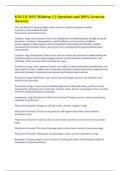Exam (elaborations)
KIN 311 OSU Midterm 2 || Questions and 100% Accurate Answers.
- Course
- Institution
Fitts and Posner's Learning Stages correct answers Cognitive (beginner learner) Associative (intermediate learner) Autonomous (advanced learner) Cognitive Stage correct answers learns the fundamental movement patterns through trying the movement, watching a demonstration, verbal feedback, and ...
[Show more]



